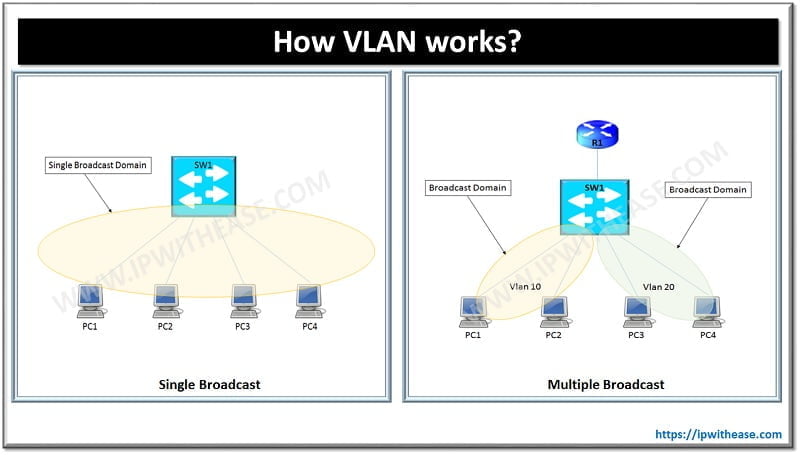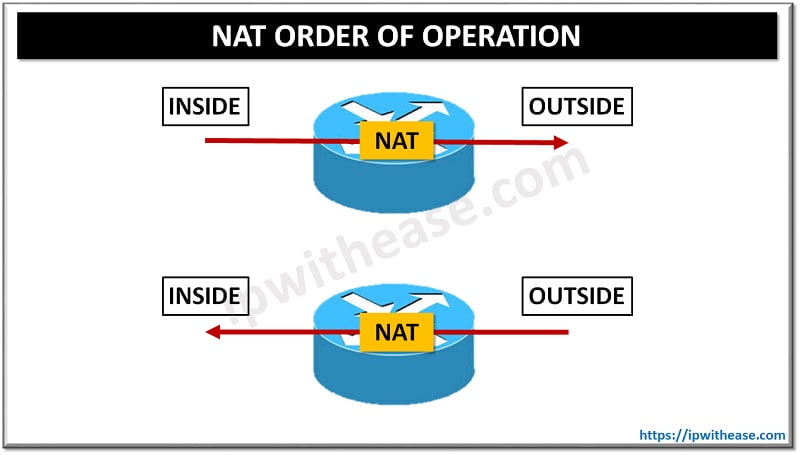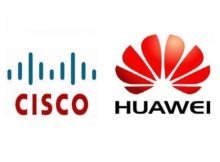In this article, we will discuss about the basics of VLAN and VxLAN, working, differences between the two (VLAN vs VxLAN), and the advantage of one over another.
What is VLAN?
As discussed in another article in detail, VLANs or Virtual Local Area Networks allow network administrators to divide a physical network into separate logical broadcast domains. By default, all hosts connected to a switch are members of the same broadcast domain.

Its Scalable up to 4094 VLANs and this limitation generated the need of VxLAN.
What is VxLAN?
VXLAN or Virtual Extensible LAN is an overlay tunnelling scheme where we can extend the layer 2 domain over a layer 3 underlay network and thereby increasing the scalability up to 16 million VxLAN segments.

Thus, we can say that VxLan is essentially an extension of VLAN that resolves the issue of scalability in large-scale network deployments.
VxLAN has been discussed in detail in another article.
The difference between VLAN and VXLAN is depicted in the below given image.

Difference between VLAN & VxLAN
As we have already discussed the difference in scalability as the basis of conception of VxLAN. Let’s dive more into the details of other differences:
- VLAN uses STP (Spanning Tree Protocol) that blocks the redundant paths to avoid traffic loops and thus allows the usage of only half of the available paths in a network. VxLAN on the hand, uses underlying Layer 3 routing protocol to use all the available ports with technologies like ECMP (Equal cost multipath Routing) etc.
- VLAN is less flexible for a muli-tenant environment, whereas VxLAN is flexible and suitable for multi-tenant environment.
- VLAN uses VLAN tag on Layer 2 frame for encapsulation to extend VLAN across switches. On the other hand, VxLAN uses MAC-in-UDP encapsulation to extend Layer2 segments across locations.
- VLAN uses 12-bit VLAN ID which limits the scalability to 4094 VLANs. Whereas, VXLAN uses 24-bit ID which scales it up to 16 Million VXLAN segments.
Comparison Table: VLAN vs VxLAN
Below table summarizes the discussed differences into easily understandable format.
PARAMETER | VLAN | VxLAN |
| Full form | Virtual Local Area Network | Virtual Extensible LAN |
| Definition | Layer 2 partitioned & isolated broadcast domain in a network. | Overlay tunnelling scheme where we can extend the layer 2 domain over a layer 3 underlay network. |
| Scalability | Scalable up to 4094 VLANs. | Scalable up to 16 million VXLAN segments. |
| VLAN ID | VLANs use 12-bit VLAN ID which limit to 4094 VLANs. | VXLAN uses 24-bit ID which scales it up to 16 Million VXLAN segments. |
| Protocol | VLAN uses STP which blocks redundant paths and hence allows using only half of available paths. | VXLAN uses underlying Layer 3 routing protocol to use all the available parts with technologies like ECMP (Equal cost multipath Routing) etc. |
| Flexibility | Less flexible for multitenant environment. | Flexible and suitable for multitenant environment. |
| Working | Uses VLAN tag on Layer 2 frame for encapsulation to extend VLAN across switches. | Uses MAC-in-UDP encapsulation to extend Layer2 segments across locations. |
Download the comparison table: VLAN vs VxLAN
Why to choose VXLAN over VLAN?
As mentioned, VXLAN uses overlay tunnelling scheme where we can extend the layer 2 domain over a layer 3 underlay network. This eliminates the need to use Spanning Tree Protocol, which blocks the redundant paths to avoid traffic loops and thus allows the usage of only half of the available paths in a network. With the elimination Spanning Tree Protocol, none of the paths are blocked, and you can use the full value of the available paths. Hence, to maximize the performance of data center, VxLAN is a better choice over VLAN.
Moreover, with the advent of virtualization and cloud data centers which demands more complex, scalable and dynamic cloud VXLAN makes a dramatic difference.
Continue Reading:
What is VXLAN (Virtual Extensible LAN)
What is the difference between VxLAN and OTV?
Are you preparing for your next interview?
If you want to learn more about VxLAN, then check our e-book on VXLAN Interview Questions and Answers in easy to understand PDF Format explained with relevant Diagrams (where required) for better ease of understanding.
ABOUT THE AUTHOR

You can learn more about her on her linkedin profile – Rashmi Bhardwaj



